
The Spanish painted frog, in Spanish sapillo pintojo meridional, is a species of frog in the family Alytidae. It is endemic to Spain.

The Tyrrhenian painted frog is a species of frog in the family Alytidae.

Main's frog is a species of frog in the subfamily Pelodryadinae. It is endemic to western and central Australia. The frog is named after Professor Bert Main of the University of Western Australia, a pioneer of southern Western Australia frogs.
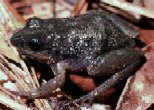
The southern chorus frog is a species of frog in the family Hylidae, endemic to the southeastern United States. Its natural habitats are temperate forests, temperate grassland, shrub-dominated wetlands, swamps, freshwater marshes, intermittent freshwater marshes, ponds, open excavations, seasonally flooded agricultural land, and canals and ditches. It is threatened by habitat loss.

Afrixalus fornasini is a species of frog in the family Hyperoliidae and is native to Africa. Its common name is Fornasini's spiny reed frog or the greater leaf-folding frog

The Natal banana frog also known as the Natal Leaf-folding Frog is a species of frog in the family Hyperoliidae. It is found in South Africa and possibly Lesotho. Its natural habitats are temperate forests, temperate shrubland, swamps, intermittent freshwater marshes, arable land, rural gardens, ponds, and canals and ditches. It is threatened by habitat loss.
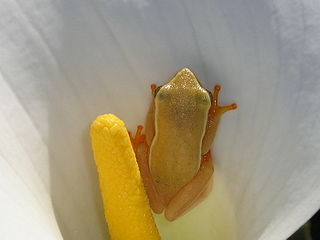
The arum lily reed frog, Horstock's arum-frog, arum lily frog, or Horstock's reed frog is a species of frog in the family Hyperoliidae. It is endemic to South Africa.

Phlyctimantis maculatus is a species of frog in the family Hyperoliidae. They are silvery greyish-brown with dark brown to black spots, and derive their name from bright red coloring on the ventral side of their hind legs. Adult body length is typically 6 to 7.5 centimeters. These frogs have vertical pupils. Common names include red-legged running frog, brown-spotted tree frog, red-legged Kassina, red-legged pan frog, spotted running frog, tiger leg running frog, and vlei frog.
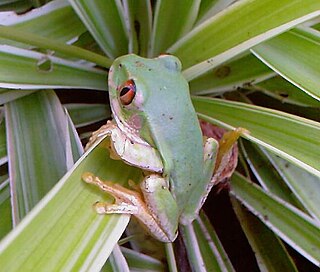
The Natal forest tree frog is a species of frog in the family Arthroleptidae, subfamily Leptopelinae, and is endemic to the eastern coastal area of South Africa. A typical tree frog, it has large eyes and a broad mouth. Its colouration is highly variable: Some may be bright green, others cream coloured, and some may be cream with olive-green blotches.
The long-toed tree frog is a species of frog in the family Arthroleptidae found in South Africa and possibly Lesotho. Its natural habitats are temperate grassland, swamps, freshwater marshes, and intermittent freshwater marshes.

Pleurodema thaul, the Chilean four-eyed frog is a species of frog in the family Leptodactylidae. It is found in Argentina and Chile. Its natural habitats are subantarctic forests, temperate forests, temperate shrubland, temperate grassland, rivers, intermittent rivers, swamps, freshwater lakes, intermittent freshwater lakes, freshwater marshes, intermittent freshwater marshes, pastureland, plantations, rural gardens, urban areas, water storage areas, ponds, open excavations, sewage treatment areas, irrigated land, seasonally flooded agricultural land, and introduced vegetation. It is threatened by habitat loss.
The small western froglet is a species of frog in the family Myobatrachidae. It is endemic to Australia. Its natural habitats are temperate forests, subtropical or tropical seasonally wet or flooded lowland grassland, swamps, freshwater lakes, intermittent freshwater lakes, freshwater marshes, and intermittent freshwater marshes. It is threatened by habitat loss.

The Central Asiatic frog, or Asian frog, is a species of true frog, found in China, Kazakhstan, and Kyrgyzstan. Its natural habitats are temperate forests, temperate shrubland, temperate grassland, rivers, intermittent rivers, swamps, freshwater lakes, intermittent freshwater lakes, freshwater marshes, intermittent freshwater marshes, freshwater springs, inland deltas, arable land, pastureland, rural gardens, urban areas, water storage areas, ponds, aquaculture ponds, and irrigated land. It is not considered threatened by the IUCN.

The Greek stream frog, or simply Greek frog, is a species of frog in the family Ranidae found in Albania, Bosnia and Herzegovina, Bulgaria, Greece, North Macedonia, Serbia and Montenegro, and Turkey. Its natural habitats are temperate forests, temperate grassland, rivers, intermittent rivers, freshwater springs, and pastureland. It is not considered threatened by the IUCN.

The long-legged wood frog, also known as Caucasus frog, Brusa frog, or Uludağ frog, is a species of frog in the family Ranidae found in Armenia, Azerbaijan, Georgia, Iran, Russia, Turkey, and Turkmenistan.

The Perez's frog, also known as Iberian waterfrog, Iberian green frog or Coruna frog, is a species of frog in the family Ranidae. It is native to southern France, Portugal, Spain, and has been introduced to the Canary and Balearic Islands, Madeira, the United Kingdom, and the Azores. In the Iberian Peninsula it is widespread and common.
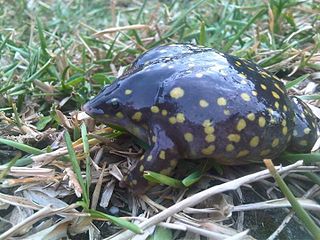
The spotted snout-burrower, or spotted shovelnose frog, is a species of frog in the family Hemisotidae, found in South Africa and possibly Eswatini.

The Iberian parsley frog is a species of frogs in the family Pelodytidae, known as "parsley frogs" because of their green speckles. This species is only found in Portugal and Spain; in Spanish it is known as sapillo moteado ibérico.

The Congo clawless otter, also known as the Cameroon clawless otter, is a species in the family Mustelidae. It was formerly recognised as a subspecies of the African clawless otter.
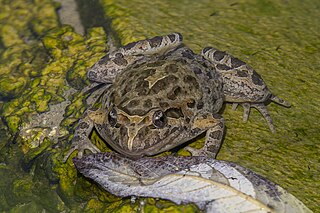
Discoglossus pictus, the Mediterranean painted frog or simply painted frog, is a species of frog in the family Alytidae.




















